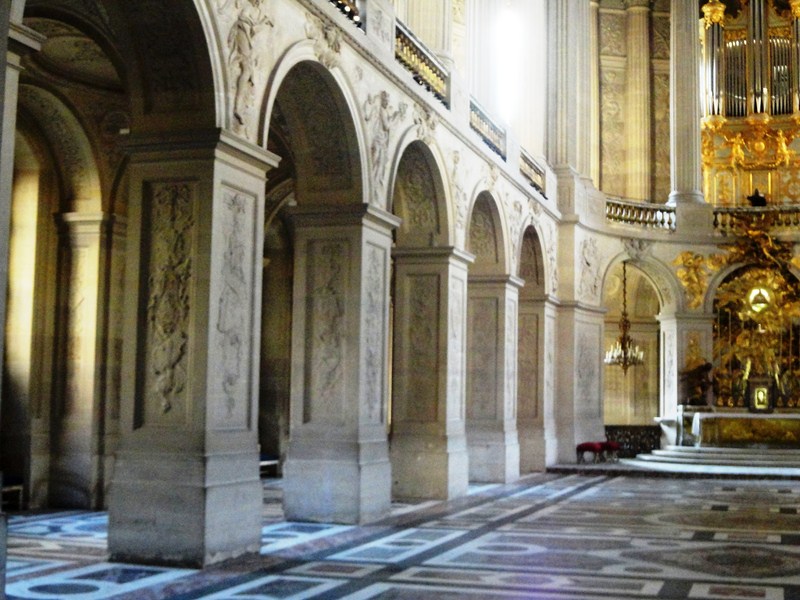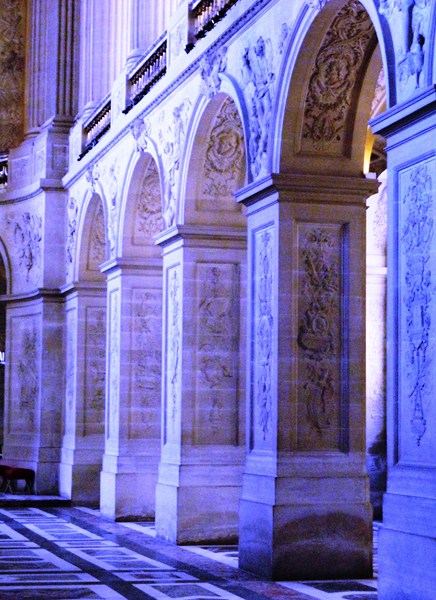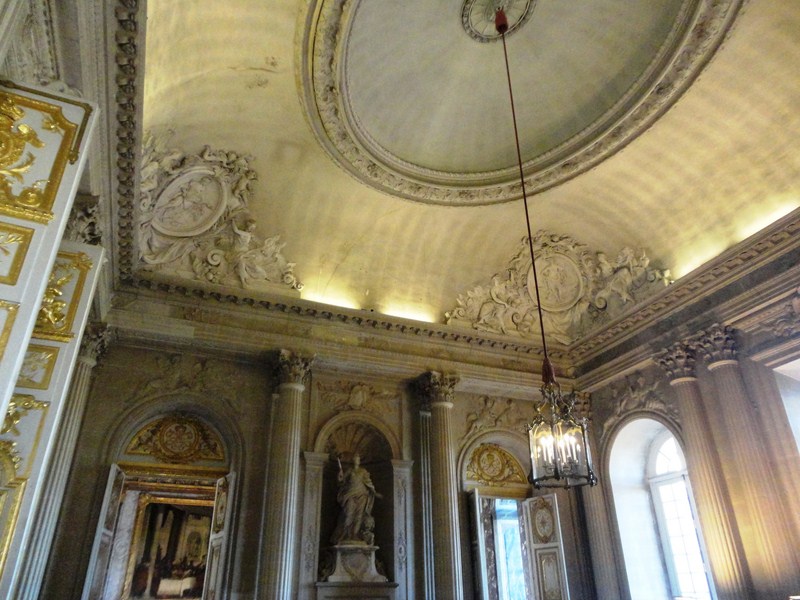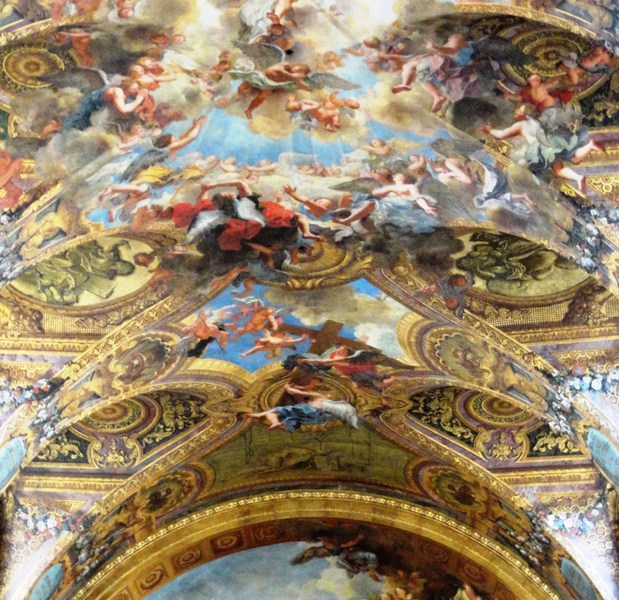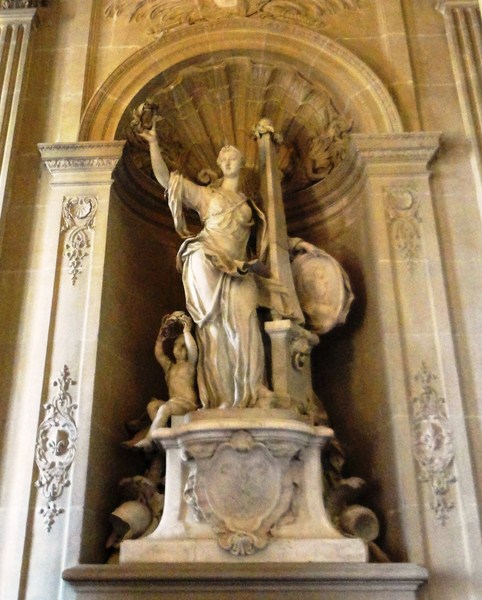Upon arriving from the Place d’Armes, we caught sight of the Royal Chapel of Versailles’ sleek form, with a stonework facade opening up by large windows and its roof ridge reaching a height of 40 m. (the Royal Chapel is several dozen meters higher than the surrounding buildings). The current chapel, located at the south end of the north wing, was the last major building project at Versailles to be completed during the reign of Louis XIV (his spiritual legacy as well) and the fifth and final chapel built in the Palace since the reign of Louis XIII.
Check out “Versailles Palace“
Officially announced in 1682, construction was begun by Jules Hardouin-Mansart (the First Architect to the King) in 1699 and, after Hardouin-Mansart died in 1708, the chapel was completed by his assistant and brother-in-law Robert de Cotte. It was consecrated on June 5, 1710, at the end of the reign of Louis XIV, by Cardinal Louis Antoine de Noailles, the Archbishop of Paris.
Along with the Hall of Mirrors, it is one of the jewels of the Palace of Versailles. The Chapel, a treasure of sacred architecture in France, is an impressive showpiece, of that time, of the proliferation of art to express the divine.
Hardouin-Mansart perpetuated the architectural tradition of French royal chapels, while giving the building a very modern appearance, consistent with Versailles’ “grand royal style.” He was also responsible for the Hall of Mirrors, the other major project at the end of the Sun King’s reign.
Representing one of the finest examples of French Baroque architecture and ecclesiastical decoration, the chapel towers over the rest of the palace. It was dedicated to Louis IX of France, the patron saint of the King and an ancestor of the royal house.
Many believe that the Chapel contains references to the Sainte-Chapelle of Paris which Louis IX had founded on Île de la Cité in the 1240s, notably its large windows that let in the light, as well as its height (40 m.) on a squat and streamlined, 24 m. wide and 42 m. long base, made possible by its interior colonnade.
The Royal Chapel stands out for its rich artistic expression, both inside and out. The building’s overall design, with Gothic-inspired architecture, features many monumental sculpted decorations. There are large glass windows, Corinthian pilasters topped with plant decorations, buttresses, a roof with decorative lead work that was covered in gold leaf during the Sun King’s time plus an imposing colonnade on the first floor clearly inspired by Antiquity.
No fewer than 30 statues, made by 16 different sculptors, top the balustrade and the Chapel’s central pediment. Their carefully chosen themes are a combination of major characters in Christianity and allegories of Christian virtues.
The interior elevation, like other royal chapels, follows the usual format for Palatine chapels (the most obvious examples is the presence of a balcony) with two levels. The free-standing columns let in bright light from the large panes of clear glass (a luxury at the time). Daily services here were usually held in the morning at 10 AM with the King, surrounded by his family, worshiping in the Royal Tribune on the upper level, with the ladies of the Court occupying the lateral tribunes, while the Officers and members of the public were seated or stood in the nave parterre on the ground level.
The king only descended into the nave during religious celebrations when he took Holy Communion, ceremonies of the Order of the Holy Spirit, and the baptisms and weddings of the Princes and Princesses of the realm which were held there from 1710 to 1789.
The Hardouin-Mansart-designed uninterrupted vaulted ceiling, without transverse ribs to create a unified surface, display striking frescoes, complemented by large stained-glass windows, done by the most talented painters of the time, with scenes depicting the three figures of the Holy Trinity.
The Glory of the Father Announcing the Coming of the Messiah, in the center, was done by Antoine Coypel. In the apse above the altar is The Resurrection of Christ by Charles de La Fosse while above the royal tribune is The Holy Spirit Descending upon the Virgin and the Apostles by Jean Jouvenet.
A corridor and vestibule, connecting the Chapel and the State Apartments, included later art commissioned by Louis XV, intended to portray the link between Divinity and the King – a statue of Glory Holding the Medallion of Louis XV, by Antoine Vassé; and Royal Magnanimity by Jacques Bousseau.
The great organ, designed by Clicquot, is decorated with a beautiful depiction of King David in relief and was unusually placed above the altar, thus facing the gallery where the royal family sat to attend mass. Great musicians, such as François Couperin (he inaugurated the organ), have played this organ. Every day, throughout the service, the music of the Chapel, renowned throughout Europe, rang out with motets resonating from above the altar.
More than 300 years after its construction, the acoustics of this exceptional musical venue still resonates as the chapel continues to host concerts, playing a large repertoire of sacred and secular music from that time and the present day.
NOTE: More than forty years after its last major restoration, the Royal Chapel is now undergoing urgent intervention on the roof timbers, the roof and decorative lead work, the statues and window frames and stained glass.The end of the construction is scheduled for spring 2021.
Hall of Mirrors: Chateau De Versailles, Place d’Armes, 78000 Versailles, France. Tel: +33 1 30 83 78 00. Website: www.chateauversailles.fr. Open daily (except on Mondays and May 1), from 9:00 AM to 6:30 PM. Last admission is 6 PM while the ticket office closes at 5.45 PM. The estate of Trianon and the Coach Gallery only open in the afternoon while the Park (7 AM to 8:30 PM) and Gardens (8 AM to 8.30 PM, last admission: 7 PM) are open every day. Access to the Gardens is free except on days of fountains shows. You can access the estate of Trianon through the Gardens or through the city. The Petit Trianon is only possible via the Grand Trianon.
Admission: 27 € for Passport with Timed Entry (days with Musical Fountains Shows or Musical Gardens), 20 € for Passport with Timed Entry (without musical fountains show or musical gardens), 12 € for Estate of Trianon ticket(without Musical Fountains Show or Musical Gardens), 10 € for Passport with Timed Entry (free admission, days with Musical Fountains Show or Musical Gardens), 9,50 € for Musical Fountains Show ticket, 8,50 € for Musical Gardens ticket, 28 € for the Fountains Night Show.
How to Get There: The cheapest option for reaching Versailles is by train. There are three train stations in Versailles. RER line C arrives at Versailles Château – Rive Gauche train station, the closest one of the Palace (just 10 minutes’ walk to the Palace). SNCF trains from Gare Montparnasse arrive at Versailles Chantiers train station, which is 18 minutes on foot to the Palace. SNCF trains from Gare Saint Lazare arrive at Versailles Rive Droite train station, 17 minutes on foot to the Palace. RER C and SNCF train times are available on www.transilien.com





